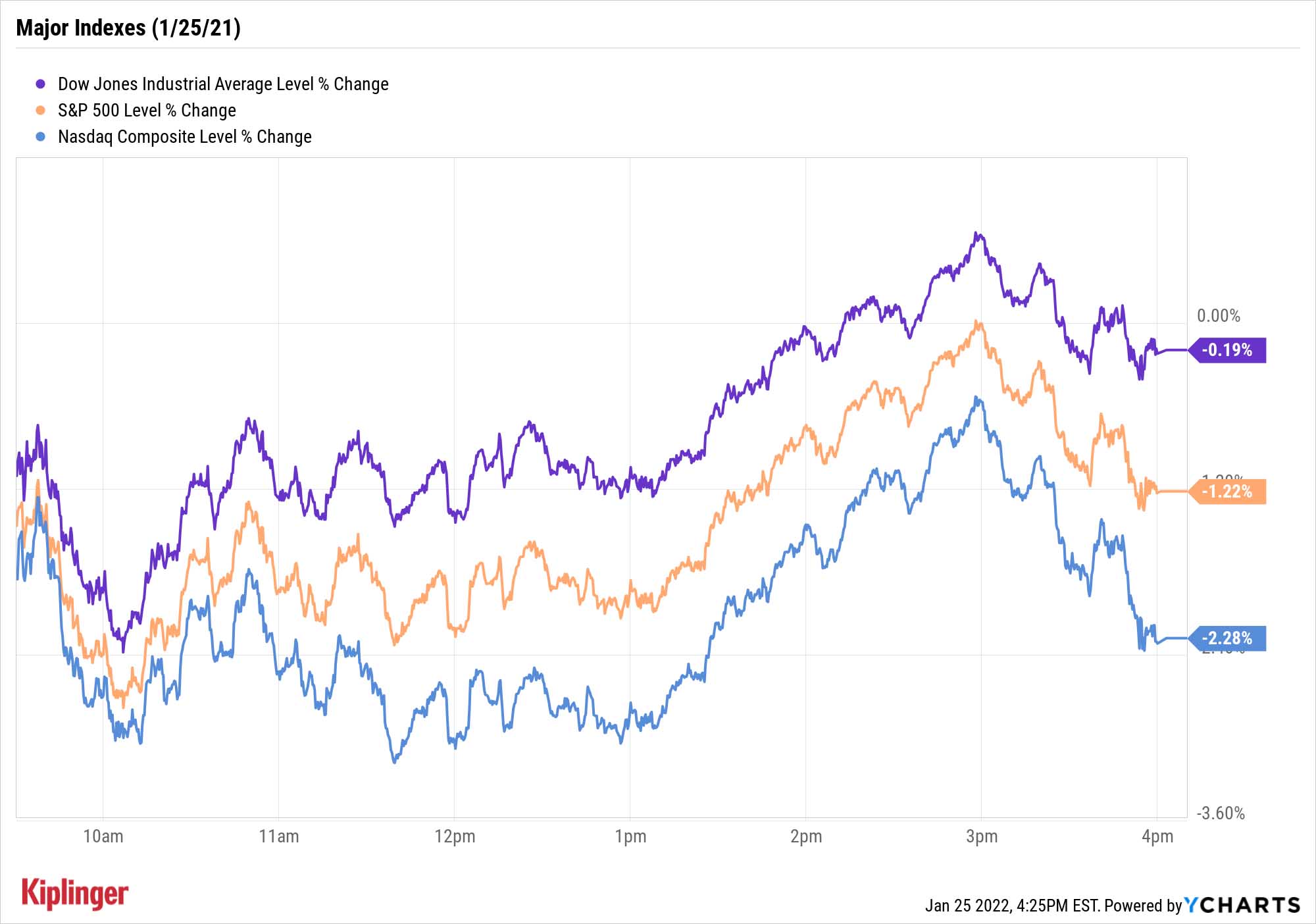Stock Market Today: Stocks End Down on Another Roller-Coaster Day
The major indexes stage another comeback Tuesday but this time can't escape declines; Microsoft falls after hours despite an earnings beat.


Another day, another market session of gut-wrenching volatility.
Like Monday, Tuesday's action saw a precipitous market plunge in the morning hours before the bulls took over in the afternoon – though unlike Monday, none of the major indexes managed to finish in positive territory.
One of the primary reasons for all the rips and dips, of course, is jitters over tomorrow's conclusion of the Federal Reserve's latest two-day meeting, when America's central bank is expected to continue projecting a recent hawkish bent, setting the stage for a potential March hike to its benchmark interest rate, likely the first of several across 2022.
From just $107.88 $24.99 for Kiplinger Personal Finance
Become a smarter, better informed investor. Subscribe from just $107.88 $24.99, plus get up to 4 Special Issues

Sign up for Kiplinger’s Free Newsletters
Profit and prosper with the best of expert advice on investing, taxes, retirement, personal finance and more - straight to your e-mail.
Profit and prosper with the best of expert advice - straight to your e-mail.
"It's been breathtaking to watch the dramatic change in expectations surrounding the Fed this year," says Kristina Hooper, Invesco chief global market strategist. "Estimates for rate hikes are all over the place, but they've been trending a lot higher in the past couple of weeks — and we've seen stocks and other risk assets fall in response. There are whispers that the Fed will end asset purchases at this week's meeting; others think the Fed could start to raise rates at this week's meeting.
"And some are anticipating as many as eight rate hikes this year — that may be worse than the giant eight-legged hairy spider under the bed that wanted to kidnap my daughter and bring her back to its human-sized web."
Leading the way in an uneven market was the energy sector (+3.8%), where stocks including ConocoPhillips (COP, +4.9%) and EOG Resources (EOG, +4.5%) were buoyed by U.S. crude oil prices (+2.8% to $85.60 per barrel). Oil surged amid heightening tensions not just between Ukraine and Russia, but also in the Middle East; the United Arab Emirates intercepted two missiles targeting an air base near its capital, Abu Dhabi, an attack it blamed on Iran-backed Houthi rebels.
Financial stocks (+0.5%) were relatively strong, too, as American Express (AXP, +8.8%) clobbered fourth-quarter revenue and profit expectations thanks to record levels of card spending.
The Dow Jones Industrial Average, off 819 points at the session lows, recovered to post a far more modest 66-point, 0.2% decline to 34,297. The S&P 500 (-1.2% to 4,356) and Nasdaq Composite (-2.3% to 13,539) also finished off the bottom, but with more substantial declines.
Microsoft (MSFT, -2.7%) was off another 3% or so in early after-hours trading following a solid top- and bottom-line beat for its fiscal second quarter. Revenues of $51.73 billion were up 20% year-over-year and topped expectations for $50.88 billion. Earnings of $2.48 per share also easily topped estimates of $2.31. Leading the company's quarter was a 25.5% pop in revenue growth in the Intelligent Cloud segment, which includes Azure, GitHub and other products.

Other news in the stock market today:
- The small-cap Russell 2000 declined 1.5% to 2,004.
- Gold futures rose 0.6% to settle at $1,852.50 an ounce.
- Bitcoin futures were off slightly, down 0.8% to $36,886.86. (Bitcoin trades 24 hours a day; prices reported here are as of 4 p.m.)
- General Electric (GE) stock took a 6.0% dive after the industrial conglomerate reported its fourth-quarter results. While GE reported adjusted earnings per share of 92 cents and free cash flow of $8.3 billion – more than the 84 cents per share and $3.2 billion analysts were expecting – revenue of $20.3 billion fell short of the consensus estimate for $21.4 billion in sales.
- Higher-than-expected adjusted fourth-quarter earnings ($2.13 reported vs. $2.12 expected) and an upbeat full-year forecast gave Johnson & Johnson (JNJ) stock a 2.9% boost, even as the pharmaceutical giant's $24.8 billion in revenues fell short of the $25.3 billion analysts' were anticipating. CFRA Research analyst Stewart Glickman maintained a Buy rating on JNJ in the wake of earnings. "JNJ noted that its net debt position is now its lowest in almost five years, even as research and development rose 20% in 2021, which we think could spur management to boost dividends or perhaps pursue acquisitions (in our view, we see the latter as more likely)," he says.
- Nvidia (NVDA) fell 4.5% after Bloomberg News reported the semiconductor giant is preparing to abandon its bid for U.K. chip designer Arm, according to people familiar with the matter. The potential deal, which was first announced in September 2020, has faced numerous regulatory hurdles. Per the Bloomberg report, Softbank, which owns Arm, may be considering taking the company public.
The Newest Dividend Aristocrats
Coming soon to an index near you: the coronation of new dividend royalty.
When investors put together their income portfolios, some hone in on high yield, others focus on high-frequency (read: monthly) payers, and still others try to stack several stocks that reliably grow their dividends over time.
Dividend growth boasts numerous benefits, among them achieving higher yields over time for simply holding onto the stocks you already like, and having something of a built-in cushion against inflation – after all, if your dividend isn't growing but the costs of goods and services are, the effective income you're receiving from those stocks is effectively shrinking.
When it comes to dividend growth, it's hard to do it better than the S&P 500 Dividend Aristocrats – payout champions that have raised their annual distributions for at least 25 years without interruption. And as of February, this peerage will be a little different.
S&P Dow Jones Indices recently announced a few changes to the Aristocrats, effective before the open of business on Feb. 1, that will see two new companies join their ranks … and a name that was once synonymous with fat dividends be dethroned. Check out the link above to discover who's in, who's gone and who remains.
Kyle Woodley was long NVDA as of this writing.
Profit and prosper with the best of Kiplinger's advice on investing, taxes, retirement, personal finance and much more. Delivered daily. Enter your email in the box and click Sign Me Up.
Kyle Woodley is the Editor-in-Chief of WealthUp, a site dedicated to improving the personal finances and financial literacy of people of all ages. He also writes the weekly The Weekend Tea newsletter, which covers both news and analysis about spending, saving, investing, the economy and more.
Kyle was previously the Senior Investing Editor for Kiplinger.com, and the Managing Editor for InvestorPlace.com before that. His work has appeared in several outlets, including Yahoo! Finance, MSN Money, Barchart, The Globe & Mail and the Nasdaq. He also has appeared as a guest on Fox Business Network and Money Radio, among other shows and podcasts, and he has been quoted in several outlets, including MarketWatch, Vice and Univision. He is a proud graduate of The Ohio State University, where he earned a BA in journalism.
You can check out his thoughts on the markets (and more) at @KyleWoodley.
-
 Dow Hits New High Then Falls 466 Points: Stock Market Today
Dow Hits New High Then Falls 466 Points: Stock Market TodayThe Nasdaq Composite, with a little help from tech's friends, rises to within 300 points of its own new all-time high.
-
 The Best Vanguard Bond Funds to Buy
The Best Vanguard Bond Funds to BuyInvestors seeking the best Vanguard bond funds can pick between mutual funds and ETFs spanning maturities, credit qualities, tax treatment and geographies.
-
 Are You Afraid of an IRS Audit? 8 Ways to Beat Tax Audit Anxiety
Are You Afraid of an IRS Audit? 8 Ways to Beat Tax Audit AnxietyTax Season Tax audit anxiety is like a wild beast. Here’s how you can help tame it.
-
 Dow, S&P 500 Rise to New Closing Highs: Stock Market Today
Dow, S&P 500 Rise to New Closing Highs: Stock Market TodayWill President Donald Trump match his Monroe Doctrine gambit with a new Marshall Plan for Venezuela?
-
 'Donroe Doctrine' Pumps Dow 594 Points: Stock Market Today
'Donroe Doctrine' Pumps Dow 594 Points: Stock Market TodayThe S&P 500 rallied but failed to turn the "Santa Claus Rally" indicator positive for 2026.
-
 Stocks Struggle for Gains to Start 2026: Stock Market Today
Stocks Struggle for Gains to Start 2026: Stock Market TodayIt's not quite the end of the world as we know it, but Warren Buffett is no longer the CEO of Berkshire Hathaway.
-
 If You'd Put $1,000 Into Lowe's Stock 20 Years Ago, Here's What You'd Have Today
If You'd Put $1,000 Into Lowe's Stock 20 Years Ago, Here's What You'd Have TodayLowe's stock has delivered disappointing returns recently, but it's been a great holding for truly patient investors.
-
 Stocks Extend Losing Streak After Fed Minutes: Stock Market Today
Stocks Extend Losing Streak After Fed Minutes: Stock Market TodayThe Santa Claus Rally is officially at risk after the S&P 500's third straight loss.
-
 If You'd Put $1,000 Into 3M Stock 20 Years Ago, Here's What You'd Have Today
If You'd Put $1,000 Into 3M Stock 20 Years Ago, Here's What You'd Have TodayMMM stock has been a pit of despair for truly long-term shareholders.
-
 Santa Claus Rally at Risk as Tech Stocks Slump: Stock Market Today
Santa Claus Rally at Risk as Tech Stocks Slump: Stock Market TodayThe Nasdaq Composite and Dow Jones Industrial Average led today's declines as investors took profits on high-flying tech stocks.
-
 Cooler Inflation Supports a Relief Rally: Stock Market Today
Cooler Inflation Supports a Relief Rally: Stock Market TodayInvestors, traders and speculators welcome much-better-than-hoped-for core CPI data on top of optimism-renewing AI earnings.
